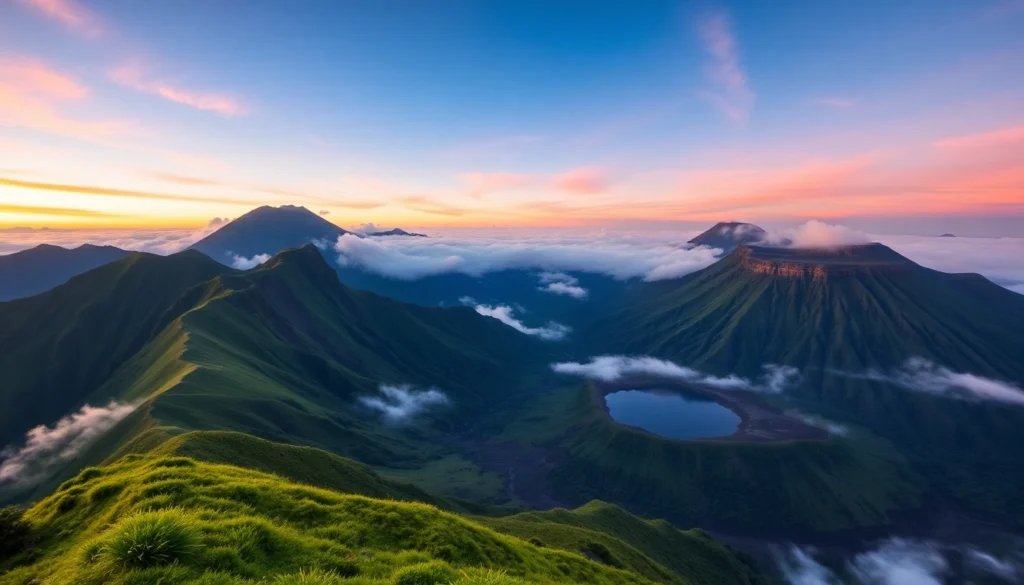
Introduction to Mount Rinjani
Standing as Indonesia’s second-highest volcano, Mt. Rinjani is a majestic and awe-inspiring geological marvel located on the island of Lombok. With an elevation of 3,726 meters (12,255 feet), it dominates the landscape and draws thousands of adventure seekers, nature lovers, and cultural enthusiasts each year. Its imposing presence is not only a testament to the island’s volcanic activity but also a vital component of Lombok’s ecological and cultural identity. Located within the boundary of the Rinjani National Park, this active stratovolcano is more than just a mountain—it is a sacred site imbued with spiritual significance, a guardian of diverse ecosystems, and a symbol of resilience and natural beauty.
The mountain’s geography is characterized by its rugged terrain, sprawling caldera, and lush forests that transition into alpine landscapes at higher elevations. Its strategic location in West Nusa Tenggara profoundly influences regional climate patterns, biodiversity, and local livelihoods. Rinjani’s volcanic activity has shaped the terrain, creating features such as lake-filled craters, hot springs, and cascading waterfalls, making it a prime destination for trekking, photography, and ecotourism.
Historical Background and Cultural Importance
Rinjani’s history is as dynamic as its geothermal activity. Its most recent eruption occurred in 2016, reminding visitors of its active status and the volcano’s potent force. However, its historical eruptions have shaped the legendary status of the mountain, deeply woven into Lombok’s mythology and spiritual life. The local Sasak and Sasak-speaking communities hold Mount Rinjani in high reverence, considering it a sacred mountain known as Gunung Rinjani or Gunung Baru. Traditional rituals and offerings are part of ongoing spiritual practices to honor the mountain’s power and seek protection.
Ancient legends tell of Rinjani as a divine abode, a place where gods and spirits reside. For centuries, local inhabitants have performed pilgrimages, festivals, and ceremonies to celebrate the mountain’s significance, blending indigenous beliefs with Islamic influences. This cultural symbiosis enhances Rinjani’s stature not just as a natural wonder but as a spiritual landscape that fosters community cohesion and cultural continuity.
Key Features and Uniqueness
Mount Rinjani’s allure is magnified by its remarkable features. The summit itself is crowned with a volcanic crater lake called Segara Anak or “Child of the Sea,” which holds freshwater and is known for its stunning turquoise hue. The lake’s geothermal activity occasionally produces steam vents and hot springs, providing therapeutic experiences for visitors.
Another distinctive characteristic is the Rinjani caldera, which measures approximately 16 by 8 kilometers, offering a natural amphitheater that encloses various landscapes, including lush forests, savannahs, and rocky outcrops. Within this caldera, Mount Baru, an active cone, periodically erupts and contributes to the dynamic volcanic landscape. The combination of volcanic features, rich biodiversity, and panoramic vistas makes Rinjani a truly extraordinary destination.
Unique to Rinjani’s environment are endemic flora and fauna, such as the Rinjani Scops Owl and the endemic Rinjani Leaf Monkey, thriving amidst diverse habitats. The mountain also serves as a critical water catchment, supplying streams and rivers vital for agriculture and local communities. Its ecological importance underscores the need for sustainable tourism and conservation efforts.
Climbing Mount Rinjani: Planning and Preparation
Best Times to Trek and Seasonal Considerations
The optimal period for embarking on a Rinjani trek is during the dry season, typically from May to September. During this window, weather conditions are more predictable, with sunny days and minimal rainfall, enhancing safety and enjoyment. The low humidity and cooler temperatures at higher altitudes provide a more comfortable trekking experience. Conversely, the rainy season from November to March brings heavy downpours, muddy trails, and increased avalanche risks, often leading to trail closures and safety concerns.
For precise planning, it’s advisable to monitor local weather reports and park advisories. The peak trekking months also coincide with festivals and cultural events, offering an added dimension to the journey.
Required Equipment and Safety Tips
Preparation is critical for a safe and successful climb. Essential gear includes sturdy hiking boots with good ankle support, layered clothing suitable for varying temperatures, warm sleeping bags, and waterproof jackets. Trekking poles are highly recommended to reduce joint strain, especially on steep descents.
Safety tips encompass conducting thorough briefings on volcanic activity, carrying sufficient water and high-energy food, and respecting environmental guidelines. It’s advisable to carry a basic first aid kit, inform someone about your itinerary, and hire experienced guides familiar with the terrain. Given the unpredictable nature of active volcanoes, climbers should stay updated on eruption alerts and park regulations.
Guided Tours vs. Independent Hikes
While independent hiking might appeal to seasoned trekkers seeking autonomy, guided tours are strongly recommended for most travelers due to safety, logistical complexity, and environmental protection. Local guides possess invaluable knowledge of the routes, weather patterns, and emergency procedures, significantly enhancing safety and enriching cultural understanding.
Operator-organized treks often include permits, porters, and acclimatization advice, ensuring that participants can focus on the experience without logistical worries. Additionally, guided tours contribute to local economies and support conservation efforts.
Trails and Routes on Mount Rinjani
Main Trekking Routes and Their Difficulty Levels
The two primary routes for climbing Rinjani are the Sembalun and Senaru trails, both offering distinct experiences and challenges. The Sembalun route, starting from the east side, is generally regarded as the more accessible and less steep path, suitable for trekkers with moderate fitness levels. It features gentle inclines and a gradual ascent through grasslands, culminating at the summit after approximately 2 to 3 days.
The Senaru route, located on the north side, is more rugged and steeper, providing a more challenging ascent suited for experienced hikers. This trail passes through lush rainforests and scenic waterfalls, culminating in a similar summit journey. The difficulty level of these routes depends on individual fitness, weather conditions, and experience.
Highlights Along Sembalun and Senaru Routes
On the Sembalun route, trekkers are treated to spectacular panoramic vistas of the surrounding valleys, terraced fields, and distant islands. The route’s highlight is reaching the rim of the caldera and witnessing the serene beauty of Segara Anak Lake nestled within the crater.
The Senaru trail emphasizes lush jungle scenery, waterfalls like Tiu Kelep and Sendang Gile, and rich biodiversity. As trekkers ascend, they encounter a variety of endemic species and unique volcanic formations. Both routes converge at the summit, offering breathtaking views of Mount Rinjani’s crater and the Indonesian archipelago.
Duration and Logistics for Multi-Day Treks
Typically, a complete ascent and descent journey spans 2 to 4 days, depending on the chosen route and pace. Most treks begin early in the morning with a transfer from local villages, and include overnight stays at designated camping sites near the summit or within the national park base camp.
Proper logistical planning involves securing permits, arranging for porters or guides, preparing camping gear, and planning food supplies. Trekking companies often package these services, easing the process and ensuring quality safety measures. Adequate acclimatization days are recommended to reduce altitude sickness risks, allowing trekkers to enjoy the experience fully.
What to Expect During the Rinjani Trek
Natural Landscapes, Waterfalls, and Volcanic Craters
The Rinjani trek offers a tapestry of natural spectacles. Starting from lush forests and eventually ascending to rugged volcanic terrains, trekkers encounter breathtaking views of the caldera, volcanic craters, and lakes. Waterfalls such as Sendang Gile and Tiu Kelep along the Senaru route provide refreshing escapes and photographic opportunities. The trail traverses through diverse ecosystems, from lowland rainforests to high-altitude grasslands, each with distinctive flora and fauna.
Wildlife and Flora in Rinjani National Park
The park is a biodiversity hotspot, hosting species endemic to Lombok and the Wallacea biodiversity transition zone. Trekkers might spot Rinjani’s endemic bird species, such as the Rinjani Leaf Monkey and the Rinjani Scops Owl. The vegetation varies from dense tropical forests to alpine shrubs, with medicinal plants and orchids adding to the botanical richness. Conservation efforts aim to protect these ecosystems from illegal logging and poaching, maintaining ecological balance.
Challenges and How to Overcome Them
Climbing Rinjani is rewarding but can be physically and mentally challenging. Common obstacles include altitude sickness, unpredictable weather, and fatigue. To mitigate these issues, proper training before the trek, gradual acclimatization, and carrying suitable gear are essential. Trekkers should also heed guide advice, stay hydrated, and pace themselves appropriately. Preparation, flexibility, and respect for the mountain’s power are key to overcoming challenges safely.
Post-Trek and Conservation
Responsible Tourism and Environmental Preservation
As one of Indonesia’s prized natural and cultural treasures, Mount Rinjani demands responsible tourism practices. Visitors are encouraged to minimize environmental impact by sticking to designated trails, carrying out waste, and avoiding disruption to wildlife. Supporting eco-friendly accommodations and local guides sustains the community and promotes preservation.
Environmental education and park regulations play pivotal roles in safeguarding this pristine landscape. Visitors must adhere to park rules, such as campfire bans and no-littering policies, to ensure the mountain’s enduring beauty for future generations.
Local Culture and Community Engagement
Engagement with local communities enhances the trekking experience and fosters cultural exchange. Many villages along the trails host traditional performances, offer local cuisine, and sell handicrafts. Participating in cultural activities, respecting sacred sites, and contributing to community-based tourism projects empower residents and help sustain their livelihoods.
Conservation initiatives often involve community participation, ensuring the mountain remains protected while providing economic benefits. Ethical tourism supports cultural preservation and promotes mutual understanding.
Tips for Future Trekkers and Maintaining Safety Standards
Future visitors should prioritize safety by securing experienced guides, preparing adequate gear, and staying informed about weather and volcanic activity. Planning ahead for permits, insurance, and emergency evacuation options is vital. Maintaining a respectful attitude towards nature and local customs enriches the experience and fosters positive interactions.
By adhering to best practices, trekkers contribute to the preservation of Mount Rinjani and uphold the high safety and environmental standards necessary for sustainable tourism.



